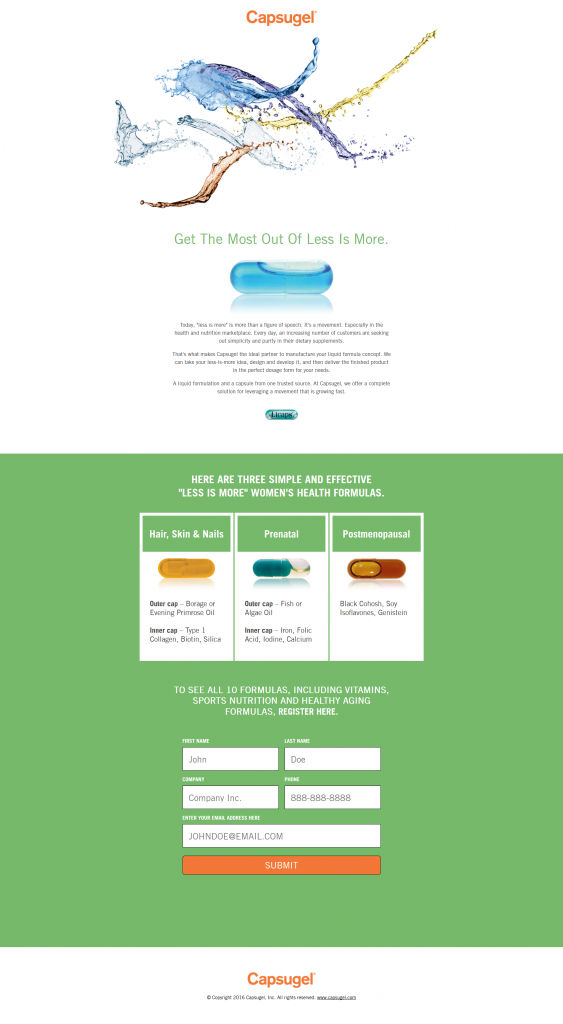Landing pages have been around a while, but companies still are unclear on exactly what they are and when and how to use them. The short and sweet of it is that all landing pages are webpages, but not all webpages are landing pages.
Essentially, a landing page is a webpage that has a singular focus—a single message about a single product or service targeted to a specific group of customers. It includes information that resonates with that targeted group, along with a specific action that you want members of that group to take. The action should be based on an established marketing strategy for that product and group of customers. For example, are you trying to generate leads, convince customers to visit your booth at a trade show, motivate customers to visit your sales center for a product demonstration or make a special offer to stimulate a faster sale? Whatever the strategy, remember that you want to tailor a singular message and offer directly to the target audience.
Note the “singular” message. Less is more. Two is too much. Three is crazy. Four is cats and dogs, living together. Mass hysteria.
 Landing pages are often used for digital, SEM and social media ad campaigns. The pages carry your branding and have a similar look as your website, but they live in a separate space. So why wouldn’t you simply link your campaign ads to a specific page on your website? That’s a common mistake. People tend to think that if you send buyers to your website, they’ll find what they’re looking for.
Landing pages are often used for digital, SEM and social media ad campaigns. The pages carry your branding and have a similar look as your website, but they live in a separate space. So why wouldn’t you simply link your campaign ads to a specific page on your website? That’s a common mistake. People tend to think that if you send buyers to your website, they’ll find what they’re looking for.
Your website serves to speak to all audiences coming from a variety of sources—organic, links, digital ads. It’s not necessarily targeted to a specific user group or offer. It’s a broader message. Websites can be information overload with no clear conversion funnel. For example, without a landing page tied to a digital campaign, you lose the ability to track conversions from those campaigns. If you simply send someone to a page on your website, you know they went to your site, but you don’t know what they did after they got there. Landing pages allow you to track conversions much more easily.
If your site’s bounce rates are high, there is a good chance you should be utilizing landing pages. Website visitors are not prone to dig for information. Research shows that most website visitors stick around for less than a minute, so if you haven’t captured their interest by then, you probably won’t.
Think of it this way, everything starts and ends with the user. That’s how you should view online traffic. (After all, it’s how Google views online traffic.) Google wants content that is relevant to a user’s search. Providing relevant content to a specific search criteria will increase your website ranking. And with landing pages, you can ensure that visitors are receiving only the information they seek.
Here are some best practices to keep in mind when creating landing pages:
• Keep your messaging consistent throughout the customer journey. In other words, make sure your landing page matches the ad visitors clicked on to get to it.
• The same applies to imagery and branding.
• Tailor landing page content specifically to the target audience.
• Include a single, clear action item that you want visitors to take on the page—
complete a form to download a whitepaper, sign up for a newsletter, etc.
• Don’t give too little or too much information. Know your audience and the amount of information it will take to entice them to take action. Remember that they are trading their information for content, so you need an appealing sell.
• Place leads in your sales funnel and remarket to them.
• Use landing pages for A/B Testing—rearrange content, change button colors or offers to determine what is more appealing to that specific group of buyers.
The current digital economy has increased the awareness of analytics. There is a ton of pressure on marketing managers to prove their ROI on all elements of the marketing budget, whether dollars or time. The more you’re able to attribute leads to media spend, the better you’re able to do your job as a marketer.








